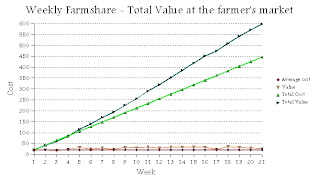Here's a rundown of many weeks of vegetables since the little guy was born.
The weights and amounts of vegetables are real. The prices are largely based on interpolation between a few farmers' markets visits, a few good guesses on things I didn't run across at the market on the weeks I went, etc. We have managed to get (and either eat, or store) our vegetables each week, but I have not been religiously going to the farmers market somehow...
9/30 - week 16
1 bunch toscano kale - $2.50/bunch
bagged lettuce mix - $4/bag
1 bunch arugula - $2.50/bunch
3 lb 2 oz potatoes - $2/lb $6.25
1 bunch celery, 1lb 1oz - $2/bunch - $2
11oz broccoli - $3/lb - $2
3 lb 10 oz carnival squash - $1.80/lb - $6.50
2 leeks - $1/ea - $2
1 lb daikon - $1.50
1 lb tomato - $2.50
3hot peppers - $0.75
Total: $32.50
10/7 – week 17
bunch of kale - $2.50
bunch of baby bok choy - $1.50/ba
bagged lettuce - $4
2 lbs potatoes - $2/lb - $4
.25lb red onion - $1/lb - $0.25
.25lb garlic - $8/lb - $2
1.5lb carrots - $1/lb - $1.50
3lbs buttercup squash - $1.80/lb - $5.40
1lb eggplants - $1.50/lb - $1.50
total: $22.65
10/14 – week 18
1 bunch dino kale - $2.50
1 bag salad greens - $4
1 bag spinach $2.50
2 lb 1 oz delicata squash (3) - $1.80/lb - $3.70
1 lb 3 oz green peppers (6) - $3/lb - $3.56
3 lb 9 oz cauliflower - $2.50/lb - $8.90
12 oz broccoli - $3/lb - $2.25
1 lb turnip - $2/lb - $2
2 leeks - $1/ea - $2
1 lb 5 oz celery (1 bu) - $2
2 lb 5 oz carrots - $1/lb - $2.13
Total: $35.54
10/21 - Week 19
1 lb 5 oz cauiflower - $2.50/lb - $3.28
3 green peppers (1 lb) -$3
1 bunch kale - $2.50
1 head escarole - $2.50
15oz beets - $2/lb - $1.87
6 oz turnip - $2/lb - $0.75
4 lb 3 oz squash – Japanese pumpkin - $1.80/lb - $7.50
3lb cabbage - $1/lb - $3
5 oz garlic - $8/lb - $2.50
2 lb 13 oz potatoes - $2/lb - $5.60
Total: $32.50
10/28 – Week 20
14 oz broccoli - $3/lb - $2.62
2lb celery - $2/bu - $2
1 bunch arugula - $2.50
1 bunch collards - $2.50
2 leeks - $1/ea - $2
2lb 6oz sweet potato - $2.60/lb - $6.17
1 lb 12 oz rutabaga - $2/lb - 3.50
4 lb 6 oz pie pumpkin - $1.80/lb - $6.56
1 lb 10 oz carrots - $1/lb - $1.62
Total: $29.47
11/4 – Week 21
1 lb 14 oz giant brussel sprouts (more than 2 pint containers, but these were weird sized) - $3/pint - $6
1 lb 5 oz celeriac - $2/lb - $2.62
1 bunch red kale - $2.50
14 oz daikon radish - $2/lb - 1.75
10 oz beets - $2/lb - $1.25
2 lb delicata squash - $1.80/lb - $3.60
7 oz red onion - $1/lb - $0.50
10 oz garlic - $8/lb - $5
3 lb 4 oz potatoes $3.25
Total: $26.47
The resulting savings has just crossed the $150 mark this week!
And the resulting plots -

















 alt=""id="BLOGGER_PHOTO_ID_5507318568551090450" />
alt=""id="BLOGGER_PHOTO_ID_5507318568551090450" />














